

- #VRAY PROXY TREES DOWNLOAD SERIAL KEY#
- #VRAY PROXY TREES DOWNLOAD FULL VERSION#
- #VRAY PROXY TREES DOWNLOAD LICENSE KEY#
You can be used it by simply dragging and dropping. It provides a large number of physical materials placed in the library. Also, provides HIDPI measuring mechanism which improves the clarity in scenes. You can assume lights in different modes to make exclusive scenes looks in the realism.
#VRAY PROXY TREES DOWNLOAD SERIAL KEY#
Vray for SketchUp 2019 Serial Key manages your assets in a well-organized way and makes proper sense of their use.Furthermore, its color picker opportunity makes almost every color code available in your architecture. Its viewport rendering characteristic allows you to import images from where ever you want without leaving the platform. You can make edges in your artwork very smoothly, however, you want it. Its latest cutting-edge feature makes it more prominent in the market. First of all, it provides the most understandable and simple interface to make stunning architectures. You can design anything that you want with its latest features.

#VRAY PROXY TREES DOWNLOAD LICENSE KEY#
Supported OS: All Windows version supportedVray 3.6 for SketchUp 2019 Crack With License Key is an amazing tool for architects and designer. Software: Vray 3.6 for SketchUp Crack.Ĭurrent Version: 2019.
#VRAY PROXY TREES DOWNLOAD FULL VERSION#
Vray 3.6 For Sketchup 2019 Crack With License Key Full Version Free Download LATESTTechnical Information. As in Max.In Revit, when I input the vraymesh, i can then assign the material.The problem is that I have to assign the material per ID.I did export the Vrmat separately for each ID channel, and then assign them inside Revit and it technically works.But it is obviously a very slow workflow when you have objects with more IDs, times the numbers of objects you need.Is there plans to implement a multimat possibility in Revit that would make possible to get the multimat from the material instead of reassign them manually? Hi,What I did is export a.vrmesh from max, and exported the material as well, into the.vrmat format.The material is a multi material, with different materials for different IDs. Then you will need to assign it V-Ray materials (which you can take either from the library or create them by yourself).Let me know if you need more help,Ana. Therefore, in v-Ray for Revit, the proxy appears first in colors. The.vrmesh format doesn't keep information about the proxy materials, it keeps only its material IDs. Therefore, they are visible only at render time. Once you have a.vrmesh, you can drag&drop it in the V-Ray Asset Browser.Note that proxies don't have visual representation in the Revit viewport. Note that if you only specify a name for the vrmesh, the output file will be saved to C:Program FilesChaos GroupV-RayV-Ray for Revittools and in case you specify a path, the vrmesh will be saved there.5. Then you need to specify the.vrmesh file name. The path to it will appear automatically. You can simply drag&drop the.obj file in the command line. See the correct syntax for the command prompt on the attached image. Basically, all you need to do is to run a command prompt from the ply2vrmesh tool location, which is C:Program FilesChaos GroupV-RayV-Ray for Revittools.How to do this: open File Explorer, go to the tools folder, then click on the File Explorer address bar (the bar where you see the path written), type in 'cmd' and click enter. You can find plenty of such files online.3. For a list of all supported file formats, which can be converted to.vrmesh, visit our help page here:A very common format is the.obj. Therefore, you will need to convert some other files to.vrmesh using the ply2vrmesh.exe converter. At that moment, we don't ship.vrmesh files yet. Once you have a.vrmesh, you can either drag&drop it over the RPC you want to replace, or you can navigate to it using the file browse dialog that pops up in the RPC Proxies tab of the V-Ray Asset Browser.2. To replace an RPC with a V-Ray Proxy first you need to have a proxy, i.e.


 0 kommentar(er)
0 kommentar(er)
